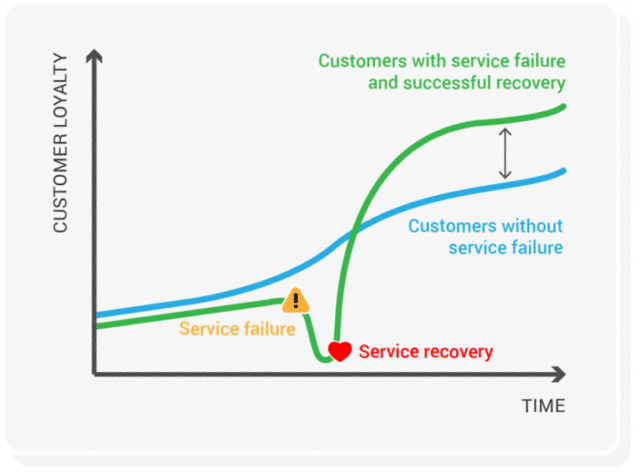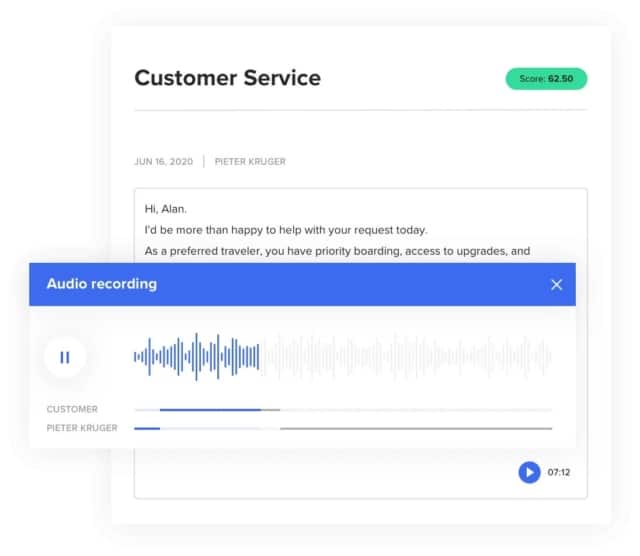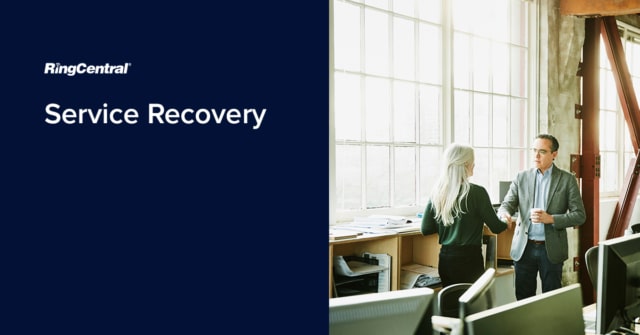Remember that old saying “the customer is always right”? It’s the key to any successful business, making sure you exceed customer expectations.
After all, unhappy customers can have a detrimental impact on your business. Not only have you lost their repeat custom, but they also won’t be recommending you to a friend. A glowing review can do wonders for your business. But, what happens when you’re left with a scathing one?
Service recovery is all about keeping the number of scathing reviews low, and customer satisfaction high.
This article will look at service recovery, and why it’s important for every business.
What is service recovery?
Service recovery is all about righting your wrongs. It’s the process of recovering from a poor customer service experience and regaining customer loyalty. The key is to react as fast as possible and rectify your errors when you spot them.
However, this is only made possible by planning for such an event. When you equip your frontline employees with the right information to assist customers, it can help to soften the blow if disaster does strike.

Successful service recovery should restore the customer’s trust, increase customer attention, and drive brand awareness. There have even been studies into it. James L. Heskett and Christopher W. Hart wrote ‘The Profitable Art of Service Recovery’, which investigates service recovery and how it can actually be useful to businesses.
What is the service recovery paradox?
The service recovery paradox is when a customer thinks more highly of your business once the problem has been rectified. And it is a situation that you can use to your advantage. This theory means that even when a customer experiences service failure if you recover the situation well enough, customers will be more loyal than they ever were before.
There are, however, a couple of conditions. Generally, the paradox applies to smaller, easier to sort issues. For example, if a customer complains because a cafe has overcharged them for their coffee, and as a gesture of goodwill the cafe refunds them and also offers them a free snack for the inconvenience. But, for bigger problems, such as password security breaches, dissatisfied customers aren’t as quick to forgive and forget.
Not only this, but the paradox is also less likely to apply if the situation could have been solved with better planning. If the problem was reasonably foreseeable, customers tend to have a smaller capacity for acceptance. For example, when an airline oversells the seats on the flight leaving some very angry holidaymakers stranded at the airport waiting for the next available plane.
Here’s a graph demonstrating this:

The two approaches to service recovery
When service recovery is part of your business plan there are two ways to look at it. Here are the main approaches to the profitable art of service recovery:
Identify the problem before it reaches the contact centre
Prevention is often regarded as the best solution. But when the problem can’t be prevented, there’s still time to rectify the situation through service recovery. This approach is all about minimising the number of customers that call the contact centre.
Businesses may want to limit this for various reasons. From ensuring the contact centre isn’t overwhelmed, to streamlining calls so the most important customer issues are resolved with an agent.
So, how can the customer’s problem be identified before it reaches the contact centre? Utilising technology is vital. Take Microsoft, for example. Sometimes a sasser computer virus – a type of software worm – can affect their operating systems. If customers have an issue with this, the quickest way to solve it is self-diagnosis and recovery steps, which can be done on their website. It’s not always necessary to call the contact centre.
Similarly, using tools like RingCentral is one way to ensure customer concerns are addressed quickly. With their Inbound Contact Centre system, customer service agents are on hand to help with customer concerns 24/7 through live chats, messaging, and social media interactions.

You can also use ‘proactive customer service’, whereby you inform the customer of a problem before it’s happened. For example, if a train operator suspects the next train will be arriving late, they can send customers an SMS message informing them.
Use service recovery to retain customers
This approach may not work for every business because it involves the service recovery paradox. Essentially, this means that if your customer experience fails but you’re able to recover the problem with great customer service, your customers remain loyal.
But, this doesn’t mean that you should allow the problem to happen. It means that should it happen, you have all the necessary measures in place to minimise damage and keep customers as happy as possible. To ensure this is the case, your contact centre must be robust and supported with skilled agents.
Importance of service recovery
Here’s a look at all of the ways service recovery is important for businesses:
Reduces negative reputation
As a business, particularly a customer-facing one, your reputation is incredibly important. You want to be able to entice new customers with your excellent customer experience reputation, as well as retain existing ones.
By implementing service recovery strategies, you’re actively taking steps to ensure your customers are satisfied, even when something goes wrong. For businesses of any size, word-of-mouth can greatly affect your reputation, but especially for small or local businesses that rely on recommendations and positive reviews. Service recovery is vital for reducing a customer’s negative experience.
Increases customer retention
Service recovery is important for customer retention. As a brand, building a solid customer relationship is one of the best things you can do. This way, customers feel as though they have an emotional connection to your business, and are more likely to stay loyal. Even in times when you let them down.
When brands are known for transparency as part of their customer experience, nearly 9 in 10 people are more likely to give them second chances after bad experiences. And 85% are more likely to stick with them during crises.
By using service recovery, you are ensuring all customer needs are met, especially when there’s a fault in your service standards.

Higher lifetime value profitability
Because service recovery increases customer retention, it means that those customers whose needs have been met have a higher lifetime value. A loyal customer is more likely to repurchase and support a business if they trust the brand. In fact, after building a relationship with customers, their spend grows alongside trust.
Eventually, they spend 57% more with brands they are loyal to. This highlights why customer lifetime value is so important to a business, because when customers are well looked after, the business benefits.
Lowers business costs
By fixing customer complaints as early on as possible, you’re reducing the number of customers that need help from agents at your contact centre. Offering customer assistance virtually means fewer calls are handled, therefore, business costs are reduced.
Also, you can analyse calls and investigate ways you can improve your business processes. This way, you’re able to prevent those problems from happening in the first place. Tools such as RingCentral can help with call analytics, as it gives you real-time insights into calls as well as the option to conduct customer surveys.
Steps for a successful service recovery plan
There are a few key steps to consider when drafting a successful service recovery plan:
1.Be proactive
Analyse customer journeys to see where problems may arise. This can help you prevent them in future. To do this, look into your website and social media analytics, conduct customer surveys, and speak to your contact centre team to determine the problems that occur most often.
You should also reach out to customers and ask them if they’re experiencing any issues. For example, like when you’re at a restaurant and the waiter asks if everything is okay with your food. This is the first step in a successful recovery plan, finding the issues and trying to quash them before they grow.
2.Decide which approach to take
As we’ve discussed, there are two different approaches to take when it comes to effective service recovery. The first is to identify the problem before it reaches the contact centre, and the second is to embrace the service recovery paradox.
To ensure your plan is consistent, you need to decide which approach works best for your business. And, remember, the aim is to ensure the customers are satisfied in the end, so don’t forget to follow-up once the issue has been solved.
3.Focus on employee training
Whichever strategy you choose you need to ensure your employees receive appropriate training. Empowerment is important for employees, they need to feel prepared and supported.

One of the training steps is to inform them of how much they can offer a customer before the matter should be escalated to a superior. For instance, you may assign employees a £20 gesture of goodwill when certain customers are particularly frustrated, but if they feel the customer deserves more, this should be checked with a supervisor.
You also need each agent to have a script, so they know how to respond when dealing with the most difficult of customers. Tools such as RingCentral are ideal for complaint handling because agents can assess customer information before they pick-up the call, and personalise the script to their needs. Agents using RingCentral are also able to answer calls remotely, meaning that more customer queries are dealt with.
Examples of service recovery
To understand what good service recovery is, let’s first look at an example of how not to approach things.
Imagine that you’ve booked a hotel but quickly realise it’s in the wrong area for your work trip, so need to cancel. If you’ve not booked directly with the hotel, you may need to contact the booking agent. First, you look online to see whether you can change your booking without the hassle of calling. Unfortunately, you can’t. So, you call the company who has your booking. But because they haven’t got efficient enough systems in place, you’re left waiting on hold for over an hour. When you finally get through, you’re speaking to the wrong department. The agent then reconnects you to the person who can help.
That agent eventually explains that due to their policy they’re unable to offer a refund, but you can change the dates. But you don’t want a date change – you want a full refund! This process can be lengthy, and even if there is some resolution, customer trust is damaged.
A good example of service recovery is one where the company aims to solve the problem in the first instance. For example, if you realise you’ve been overcharged on your phone bill your first step is to contact your phone service provider.
They have a helpful self-diagnostic problem page with useful FAQs. However, you want to speak to an advisor so click ‘live chat’. An agent pops up on your screen, and because you’re speaking to the best-skilled person to fix your problem, they are able to resolve it within minutes. And, because they want to ensure you’re fully satisfied, they offer you £10 in extra credit.
Service quality in this example is high, because your needs were met and you were also compensated.

What should you deliver in the service recovery process?
Your recovery efforts should be genuine and thoughtful to reduce customer dissatisfaction. Begin by offering the customer a sincere apology to start the recovery process. After this, service delivery is all about solving their issue and making sure you’re able to regain their trust.
To do this, you need to deliver top-notch customer service. Understand their concerns, and ensure they’re directed to an experienced agent to resolve them. RingCentral software can help with this.
Because it uses advanced features like intelligent routing, customers are always directed to the best agent for the job. That means that users are routed to the right department, the first time. Eliminating the frustration that can come with being transferred to multiple departments.

Once they’ve reached the right agent, that agent can then use RingCentral’s real-time analytics tool to view any customer information that may be relevant. This helps them to give a personalised service, even when working with a script.
And, if the customer’s query needs to be escalated, the agent can transfer the call to their supervisor and get approval straightaway. Integrating your CRM system with RingCentral can also be useful for viewing customer data.
Reporting: document it for the future
Sometimes, customer problems cannot be helped. But, when they do occur, it’s a useful learning tool for your business. You’ll have lots of data on multi-touch attribution including pain points, customer concerns, and user experience.
You may want to widen your knowledge and refer to the journal of retailing and the journal of marketing. Both aim to advance readers’ knowledge of customer service, supply chains, and management in retail and marketing environments. And this can all be used to your advantage. It’s important that you document this for the future, so you can learn from your mistakes and offer an even better customer service.
RingCentral offers invaluable analytics that you can look back over at any time. You can also create detailed reports to give you insights into what your customers are experiencing, and how your agents handle it. This is information that can allow you to be better when another customer problem arises.
So, if you’re looking to improve your service recovery, implement our steps and use helpful tools like RingCentral.
Originally published Apr 29, 2021, updated Mar 13, 2024


